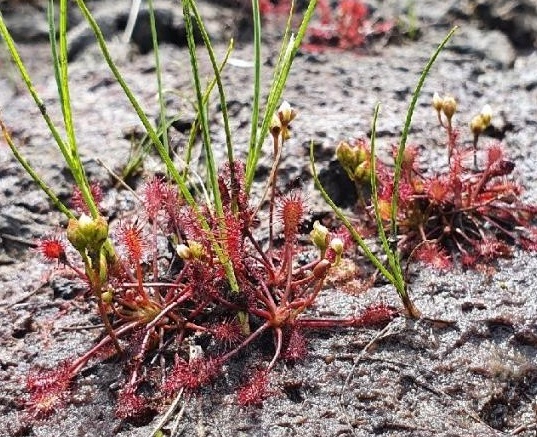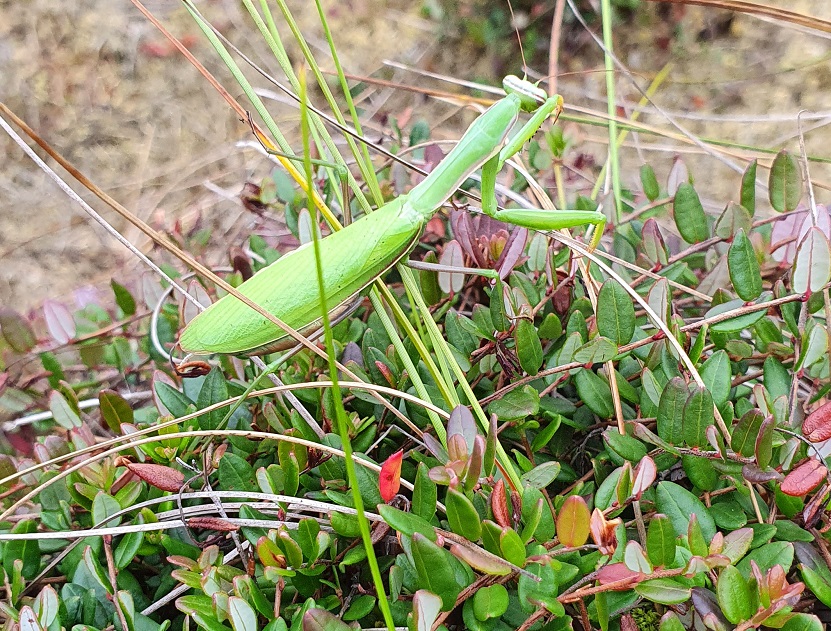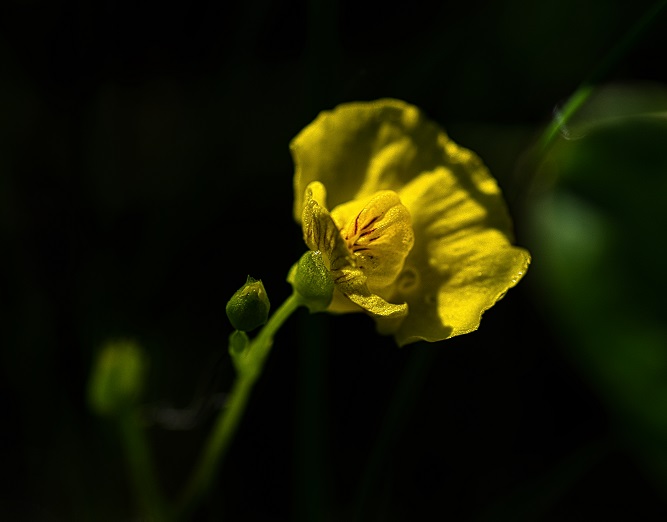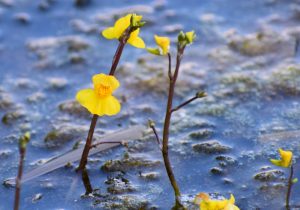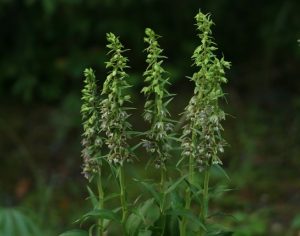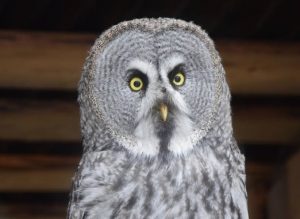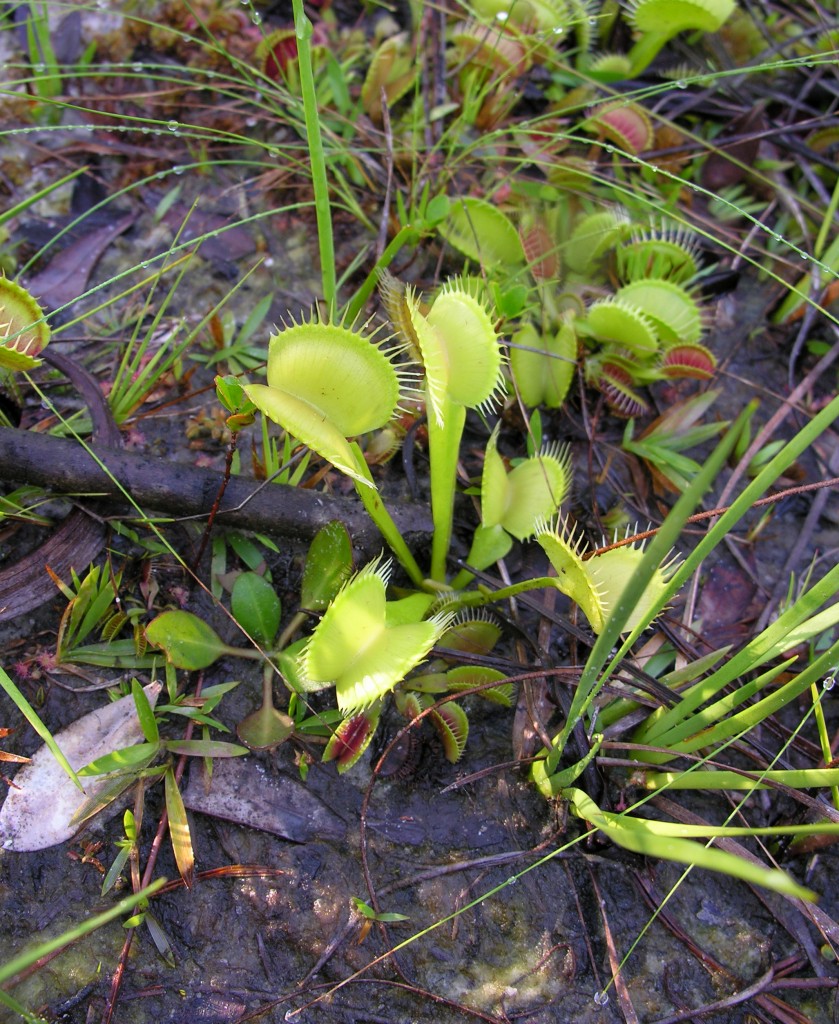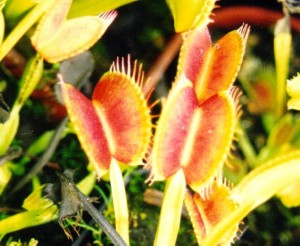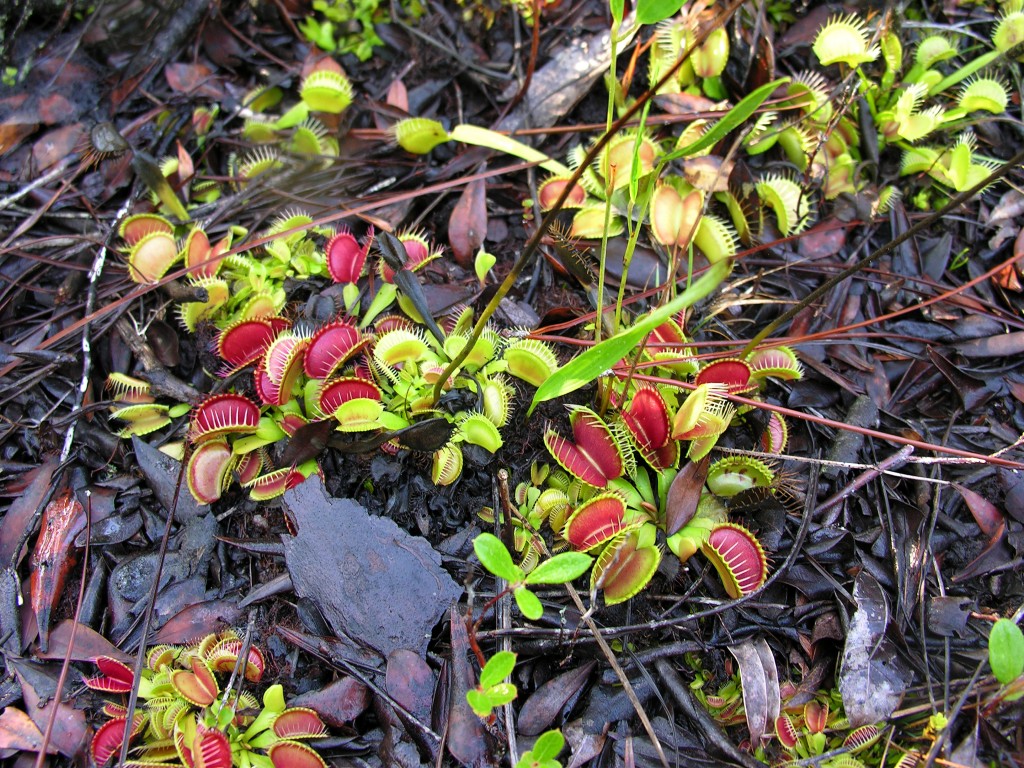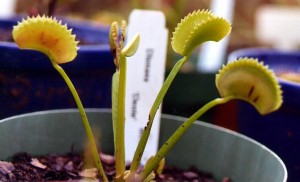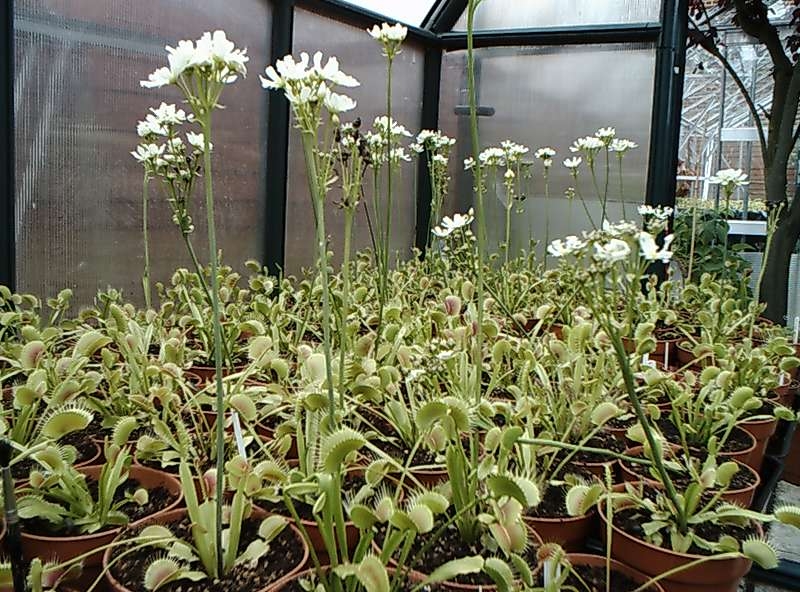In North Carolina and South Carolina on the eastern seaboard of the United States of America, there grows one of the most unusual plants in the world – the Venus Fly Trap (Dionaea muscipula). The Venus Fly Trap is famous for its ability to trap insects through its rapidly moving leaves. Each leaf consists of a pair of hinged lobes which rapidly snap shut once stimulated by a visiting insect. The trap remains closed until the victim is dead and digested and studies have shown that this remarkable movement can take place in less than half a second. So astonishing is the movement of this remarkable plant, that Charles Darwin described the Venus Fly Trap as „one of the most wonderful plants in the world”.
The earliest records of observations of the Venus Fly Trap date back to the 1760s and 1770s when several naturalists encountered the plant in the wild. On seeing the leaves of the Venus Fly Trap dramatically snap shut, the idea emerged that some plants might be adapted to the deliberate trapping of insects as prey. In 1760 Arthur Dobbs, Governor of North Carolina described Dionaea muscipula as the “Fly Trap Sensitive” and in 1770 John Ellis recorded that its leaves acted as ”a miniature form of a rat trap” and suggested that “its leaves…. May have some view towards nourishment… like a machine to catch food”.
However the notion that a plant could kill and digest living animals challenged conventional understanding of the order of the natural world and was met with disbelief. John Ellis corresponded with the great botanist Carolus Linnaeus and sent him a sketch of the trap of Dionaea muscipula and plant material. Linnaeus stated that the idea of an insect eating plant was ridiculous and that it was contrary to the God-given rules of nature. Referring to Genesis I, 29-30, Linnaeus refused to acknowledge Ellis’s findings stating that God had designed plants only for sustenance of animals and men and that the idea of plants that could wield power over animal life was blasphemous. Linnaeus was aware that insects were trapped by the sticky leaves of Drosera and Pinguicula (he formally described and named both genera) however rejected the idea that these plants had deliberate mechanisms to trap insect prey.
Finally, in 1875, the carnivorous nature of some plants was finally and conclusively established when Charles Darwin undertook a detailed and extensive study and demonstrated plainly that some plants have clear adaptations to assimilate nutrients directly through their leaves through the trapping of insect prey. Ever since the Venus Fly Trap has justifiably been considered a true carnivorous plant.
The trapping process of the Venus Fly Trap is essentially quite simple. The trap operates by attracting insect prey through its bright colouration, and possibly also secretions of sweet nectar. On the interior surface of the two lobes of the leaf, there are six very sensitive trigger hairs. If an insect is attracted to the trap and ventures inside the lobes, it has only to touch one of the sensory hairs to trigger the trap. Once activated, the two lobes rapidly snap shut through a complex process of rapid cell growth which is still not fully understood. Once closed, the trap tightens, imprisoning the trapped insect until the prey dies. Enzymes are secreted from glands on the interior surface of the trap and slowly the victim is digested after which the trap may reopen, ready to trap another insect.
The Venus Fly Trap, which has been commercially available across the world for decades, has long developed a reputation as being difficult or impossible to grow. In reality, it is not a difficult plant to cultivate successfully, once a few very important basic requirements are met.
One of the most important aspects in cultivating Venus Fly Traps is the understanding that this plant needs to grow in soil that is permanently wet but not waterlogged. For best results, pots of Venus Fly Trap plants should permanently stand in 1 cm of water, for example in a tray or container, which can be refilled with water regularly during the growing season. It is important, that the water level in the tray is several centimeters below the surface of the pot, since the Venus Fly Trap dislikes waterlogged soil which can cause the plant to rot and die. It is also important that the soil in which a Venus Fly Trap grows does not dry out completely as this will also be fatal – so caution needs to be continually applied to ensure the amount of moisture is always correct.
It is also important to consider the type of water that is used to water Venus Fly Trap plants. Like most carnivorous plants, the Venus Fly Trap is extremely sensitive to impurities in water because in its natural habitat, this plant receives only clean rain water that largely lacks nutrients or minerals. Chlorinated water from taps in most towns and cities is usually toxic to the Venus Fly Trap and most other carnivorous plants since it contains chemicals which destroy the delicate root systems of these plants. As a result, regular tap water cannot be used to water Venus Fly Trap plants since this may cause the plants to die. Instead, for best results, Venus Fly Trap plants, like most carnivorous plants, should be watered only with rain water which is free of the chemicals and more akin to the water which the plants naturally receive in the wild. Rain water should be collected for use, for example by use of a water butt or pond linked to a gutter system of a house. Collected rainwater can then be stored and used to water Venus Fly Trap plants as necessary.
Venus fly traps are also very sensitive to the type of soil in which they grow. Much like most carnivorous plants, the Venus Fly Trap evolved to become carnivorous in habitats that are deficient of nutrients and minerals and consequently their root systems are unable to absorb water or minerals if nutrient concentrations are too high. As a result, this plant needs acidic soil that is lacking in most nutrients and in cultivation, it should be planted in a compost of high grade sphagnum peat, mixed with perlite and horticultural silver sand mixed at a concentration ratio of 2:1:1 parts. The resultant compost is a soil that is suitably low in nutrients and suitably acidic which will be perfect for the Venus Fly Trap to grow in. Much like most carnivorous plants, if the Venus Fly Trap is planted in regular compost for normal house plants, it will die due to the abundance of nutrients in the soil. For the same reason, fertilizing Venus Fly Trap plants can also result in their death, and it is generally advisable not to apply any fertilizer since this plant will acquire all of the nutrients that they require through trapping insect prey.
Since the Venus Fly Trap originates from a temperate part of the world, it is naturally adapted to becoming dormant for several months of the year during the cold winter period of its habitat. In cultivation, it is important to provide the Venus Fly Trap with a cold period so that the plant can become dormant. If no period of dormancy is given, Venus Fly Trap plants will grow weak and eventually die since dormancy is an important part in the annual growth cycle of this plant. In tropical countries, a period of dormancy can be replicated by placing Venus Fly Trap plants in the fridge for a period of three or four months. During this artificial cold period, plants will stop growing and become dormant, see D’Amato (1998), Slack (1979, 1986) and Rice (2006). When removed from the fridge several months later, growth will resume with renewed vigor and the Venus Fly Trap plant will flower. It is important however, that when preparing Venus Fly Trap plants for dormancy, the soil in which the plants are grown should be allowed to drain so that when the plant is placed in the fridge, the substrate is not wet or waterlogged, which could otherwise cause living plants to rot.
One last consideration in cultivating Venus Fly Trap plants that should be taken into account is that this plant needs strong sunlight in order to grow healthily. For best results, Venus Fly Trap plants should grown in strong or preferably direct sunlight and as a general rule, the brighter the sunlight to which they are exposed, the more colourful and vigorous new growth will become. Venus Fly Trap plants that are not grown in strong sunlight will produce long, etiolated, spindly green leaves and may eventually die. In direct sunlight however, the typical form of the Venus Fly Trap plant develops spectacular yellowish green leaves with bright red colouration on the interior surface of the plants’ trap. Interestingly, the speed by which the plants’ trap moves is also connected to the intensity of sunlight to which the plant is exposed and plants growing in direct sunlight produce traps which react notably faster than specimens growing in shaded habitat.
If these five basic requirements are respected, Venus Fly Trap plants will grow healthily and vigorously. Each individual plant may produce up to thirty traps, which in healthy, mature specimens, can exceed 15 cm in total length. While it is tempting to frequently trigger the traps of this plant to observe the amazing manner in which they move, horticulturalist should be aware that this wastes a lot of the plants’ energy and if the traps are triggered continually, the overall growth of a plant is likely to slow. Venus Fly Trap plants do not need to be fed. They will catch prey on their own acquire all of the nutrients which they need. Indeed it is important not to feed Venus Fly Trap plants with meat or human foods as this will cause the plants’ leaves to rot and die.
Each year, mature Venus Fly Trap plants produce one or more inflorescences which each individually bear up to 40 white flowers. The flower of the Venus Fly Trap consists of five white petals that in some strains, each petal is lined with delicate veins. Venus Fly Traps can be self pollinated to produce seed, which can be sowed immediately or kept for several years. Seed is easily germinated on the same growing medium as recommended for mature plants, and seedlings reach maturity in approximately 3 to 6 years.
In recent years a number of spectacular cultivars of the Venus Fly Trap have been produced and registered with the International Carnivorous Plant Society. One of the most spectacular is the cultivar ‘Claytons Red’ which produces spectacular pure reddish purple leaves and traps.
Other strains produce foliage that is pure yellowish green and altogether devoid of red colouration. One further cultivar called ‘sawtooth’ varies from the typical form in that it lacks the long interlocking spine-like projects that are typical of Dionaea muscipula plants.
While the Venus Fly Trap is native to North Carolina and South Carolina, a population of this plant has been found in northern Florida near the state capital Tallahassee. While it has been previously suggested that the Floridian population of Venus Fly Traps could have been naturally introduced by the transportation of seed by migratory birds, it is now clear that the population was introduced into Florida thirty years ago. The Venus Fly Trap has also been recorded as growing prolifically along highways across the Gulf Coast states of the USA and while it is not invasive, it is a prolific plant and unnatural populations can increase in size and number very rapidly.
Unfortunately the habitat of the Venus Fly Trap in North Carolina and South Carolina has been widely destroyed over the past 100 years and today this spectacular plant can be found growing only in a fraction of its original range. Many conservation strategies are in place to ensure the remaining habitat of the Venus Fly Trap is preserved and protected for the future. One very successful strategy has been the development of a vast bank of cultivated plants to ensure that the natural diversity of the Venus Fly Trap is not lost. This is important with respect to future repopulation efforts that might take place in the future. One of the most diverse collections is the British National Collection of Venus Fly Traps owned by Mark Haslett. The collection consists of over 1,500 plants comprising more than 70 distinct strains of the Venus Fly Trap which includes virtually all known colour and size variants. Hopefully with increasing awareness of this remarkable plant, it can be protected in the wild and enjoyed in cultivation. Good luck growing this fascinating carnivorous plant.
Venus Fly Trap plants can be purchased from the following sources;
Hewitt-Cooper Carnivorous Plants (a specialist nursery that focuses on Drosera)
The Homestead, Glastonbury Road, West Pennard, Somerset, BA6 8NN, United Kingdom Website: www.hccarnivorousplants.co.ukHampshire Carnivorous Plants
Ya Mayla, Allington Lane, West End, Southampton, SO30 3HQ, United Kingdom Website: www.hantsflytrap.comP&J Carnivorous Plants
The Hayden, Brampton Lane, Madley, Hereford, HR2 9LX, United Kingdom Website: www.pj-plants.co.ukSarracenia Nurseries
37 Stanley Park Road, Carshalton, Surrey, SM5 3HT, United Kingdom Website: www.sarracenia.co.ukShropshire Sarracenias
5 Field Close, Malinslee, Telford, Shropshire, TF4 2EH, United Kingdom Website: www.carnivorousplants.uk.comBibliography
- D’Amato, P. 1998. The Savage Garden: Cultivating Carnivorous Plants. Berkeley, CA: Ten Speed Press.
- Rice, B., 2006 Growing Carnivorous Plants Portland, OR: Timber Press.
- Slack, A. 1979. Carnivorous Plants. London, England: Ebury Press.
- Slack, A. 1986. Insect Eating Plants and How to Grow Them. London, England: Alpha Books.
Stewart McPherson
